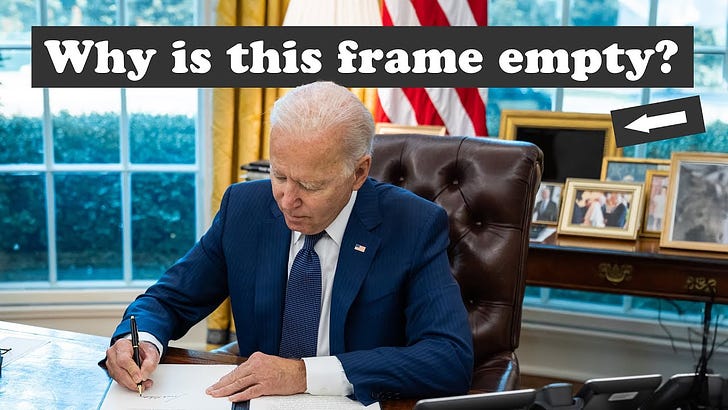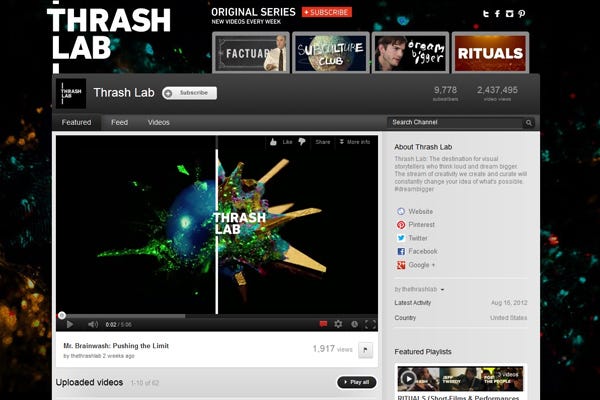I have a tendency to bury the lede, so I’ll start with the big news up top: Today I am launching a new video series simultaneously on Nebula and YouTube. You can watch the first episode at the bottom of this newsletter. Like with so many things, there is a back story. And this one began more than ten years ago… (begin wavy flashback transition)
It was 2012, and Ashton Kutcher‘s production company contacted me about developing a series for their YouTube channel.
YouTube was seven years old, but still a far cry from what it is today. It had funny home videos, clips from The Daily Show, and there were some people making original content just for the platform. But the nut hadn’t really been cracked in a way that attracted big creative brands.
So YouTube set out to intentionally change that. They reached out to musicians, actors, athletes, and “the world’s most innovative media brands,” and gave them piles of money to create content for an initiative called YouTube Original Channels.
Ashton Kutcher’s company Katalyst was one of the brands invited to participate in this program.
I was still getting my feet wet producing videos, but several of my inventor profile videos had been popular online, and they caught the eye of someone in Kutcher’s company. They sent me an email:
Katalyst was one of 30 companies given a Google grant to create a YouTube channel. Our channel is called Thrash Lab and the mandate is high end cultural content and great storytelling.
As part of this channel we are doing a content creation event that is similar to the Sundance Lab for digital content… 15 content creators in [NYC and LA] will come pitch an idea for an original web series that hasn't been shot. We will film these pitches, and show them to Ashton. Ashton will then select 12 content creators to create a sizzle reel/concept reel that serves as a visual inspiration for your series.
From those 12 that Ashton selected, six creators would get a budget to make a pilot, and then one would be commissioned for a six-episode series on their channel.
“High end cultural content and great storytelling” sounded perfect to me. This could be an opportunity to strengthen my video skills on someone else’s dime, and maybe it would boost my career. Count me in!
I only had two weeks to come up with a concept and develop my pitch. After exploring several ideas that didn’t pan out, I read somewhere that Ashton was interested in the new field of 3D printing. So I met with Bre Pettis, co-founder of MakerBot 3D printers, and developed a pitch for a series that would find a MakerBot artist in residence. It would take three “applicants” from the art world through a series of design challenges culminating in a gallery show of 3D printed art. Kinda like Project Runway but with thermoplastics instead of fabric.
The idea had its challenges — it perhaps relied too much on the need to cast interesting people and could fail if the talent was a dud — but I spent a few days refining my pitch, and I headed to YouTube’s New York Studio where I’d be presenting it.
When I arrived, I was in for a bit of a surprise.
The Big Day
The presentations were being filmed not just so Ashton could see them but because this whole search for a Katalyst YouTube series was itself being turned into a Katalyst YouTube series. I knew this but somehow had the impression it would be done in a documentary style. It turned out to be more like a reality show.
In addition to the set where I’d be pitching to the “judges”, there was an outdoor area where each contestant was interviewed so Ashton could see what we’re like on camera.
And that’s where things began to fall apart for me.
The producers set me up for my interview. It was in the low 50s out and I was cold and uncomfortable. Suddenly the camera was rolling. And they started asking me questions that had nothing to do with my pitch. The interview went something like this:
“So, tell us. What music do you listen to these days?”
I answered honestly. “Well, I have a one year old. Everything revolves around him right now so we listen to a lot of toddler music. Woody Guthrie’s kids albums are in heavy rotation.”
I saw the producer’s face fall as she realized that I was not a childless hipster with his finger on the pulse of whatever the latest craze is.
“You don’t listen to any new artists?”
“Well there is this guy Mister John who comes and plays guitar at my son’s daycare. He’s pretty good. We listen to his albums a lot, too.”
I didn’t see what any of this had to do with my video series pitch. When would they ask me questions about making videos? Or my experience making content for the internet? Or my background? Who cared what music I listened to?
I was not what they wanted and I already knew it.
Next, I went back inside where I sat on the couch under the hot lights to pitch my concept. It wasn’t well received. They were focused on the same flaw I already identified — the reliance on good casting.
I left the studio bewildered about the whole experience. I didn’t really want to be a reality show contestant. I’m not particularly comfortable on camera. This wasn’t what I thought I signed up for.
A couple weeks later, I got the unsurprising news: They did not select me as one of the finalists.
I suppose their reality show had the same flaw my pitch did: it relied a bit too much on good casting. And I was apparently a dud.
When the series finally came out on the Thrash Lab channel a few months later, I watched to see how much of my pitch made the final cut. My entire time there was reduced to a very brief clip in a montage about the pitch day. I felt both disappointment and relief. And that was the last I heard from Ashton’s company.
PBS to the rescue
I went back to making my inventor profile videos. A few months later, I got an email from PBS. They just launched their own YouTube channel, and asked if I’d be interested in expanding my inventor project as one of their first digital series. It was an easy yes. I created 20 episodes of my inventor portrait videos for PBS Digital Studios.
That launched my career as a video producer. And after my brief on-camera experience with Ashton, I happily remained behind the scenes. Over the past ten years I have written, directed, produced, and cast hundreds of videos where I turned the camera on others. Sometimes I worked with professional actors. But more often I worked with ordinary people who, like me, were not exactly naturals on camera. And that meant learning to put people at ease and coaching them on being the most camera-friendly version of themselves.
Which brings me to Nebula
A few years ago, a fellow named Dave Wiskus assembled a group of amazing creators to launch a streaming service called Nebula. It features smart, thoughtful video on science, tech, history, culture, and more. The platform is owned jointly by the company and the creators who post both original content and early-access or bonus content, all ad-free. There are podcasts and classes. It’s a treasure trove of great material that’s expanding quickly.
I’ve known Dave for a while, and I kept an eye on his service. It’s a smart business with impressive content and I was a fan. A few months ago, they crossed 600,000 paid subscribers, and I sent him a message of congratulations.
His response: “Hear me out: Ironic Sans as a Nebula series.”
“But what would a video version of Ironic Sans even be?”
“Load your newsletter into a teleprompter and you’re halfway there already.”
Ha. If it only it were that easy. But it did get me thinking. What would a video version of Ironic Sans look like? Would I need to be on camera, as is the fashion for so many essay-style YouTube videos? I did not want to be on camera. I’ve learned that I’m no good on camera. Ashton Kutcher saw me and passed, and he knows what he’s doing, right? There are ways to do this without being on camera.
But on the other hand: Sometimes you have to break out of your comfort zone. I’ve spent ten years helping other people feel comfortable on camera. Have I learned anything I could apply to myself? Or is it more like life advice, easy to give others but hard to give yourself? Maybe by being on camera, I could learn even better how to direct other people on camera.
You know what? Screw it. Let’s do it. I’m gonna be on camera. Throw caution to the wind. I’ll be awkward and uncomfortable at first, but surely I’ll get better with time, right? I don’t know, but we’ll see what happens!
Or as Dave has taken to saying: He finally bullied me into making a new series.
So what is this series?
The first few episodes will be video adaptations of some of my favorite newsletter stories. But I won’t always be cribbing from the newsletter. I’d like to do some field pieces and interviews made for video first. I have some ideas, so keep an eye out.
The best thing you can do right now is to watch the first video, hit the Like button, leave a comment, and subscribe to my YouTube channel. That will tell YouTube’s algorithm that this is content it should show other people. I’m more-or-less starting this channel from scratch, so it’s serving as a bit of a grand experiment to see if I can build a channel from nothing. And I can’t do it without you.
The other best thing you can do is to check out Nebula! I promise that you’ll find lots of stuff you like, and it’s a great way to support independent video creators.
And now without further ado…
Here is the first episode, inspired by a newsletter I wrote last year about a mysterious object in Joe Biden’s Oval Office. If you remember the secret behind the mystery, no spoilers!
So that’s my big announcement! For starters, I plan to put out a new video every month or so, and still put out this newsletter twice a month as I have been. So stick around, and I’ll see you next time!
Thanks as always. And now more than ever, I’d appreciate if you spread the word.
David









You're doing just great on camera!